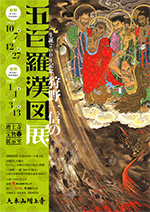 |
Picks is a monthly sampling of Japan's art scene, offering commentary by a variety of reviewers about exhibitions at museums and galleries in recent weeks, with an emphasis on contemporary art by young artists. |
 |
 |
|
|
 |
 |
 |
 |
| Curators at Work |
| 9 January - 21 March 2016 |
Tochigi Prefectural Museum of Fine Arts
(Tochigi) |
 |
| The job of curator has garnered increased visibility since the nineties, when art museums began proliferating in Japan. If curation were a board game, it would start with a presentation at a planning meeting, then advance through budget requests, grant applications, document research, selecting and negotiating for exhibits, working with displayers, producing a catalogue, writing essays and p.r. materials, and acquiring and installing the exhibited works. The goal, of course, is the Opening. The job is no picnic, as this exhibition about exhibiting attests. |
|
 |
 |
 |
 |
|
|
Kano Kazunobu's Five Hundred Arhats |
| 1 January - 13 March 2016 |
Zojoji Treasures Gallery
(Tokyo) |
 |
| The gallery at Tokyo's august Zojoji temple displays the Five Hundred Arhats by late-Edo artist Kano Kazunobu (1816-63). Though the titular sages had long been a subject of Buddhist art, Kazunobu's paintings were unprecedented in scale and an expressionistic style bordering on the bizarre. The waning days of the shogunate were a period of transition as Western art began infiltrating Japan, and Kazunobu appears to have seized the opportunity to try his hand at numerous new techniques with gusto. |
|
|
|
|

|
 |
 |
|
|
|
|
|
 |
|
|
|
|
 |
 |
|
All Begun in Kamakura, Part 3: 1951-1965: The Birth of The Museum of Modern Art, Kamakura |
| 17 October 2015 - 31 January 2016 |
The Museum of Modern Art, Kamakura
(Kanagawa) |
 |
| Highlighting works by Tetsugoro Yorozu, Harue Koga, Shunsuke Matsumoto, and Saburo Aso, this was the swan-song exhibition for The Museum of Modern Art, Kamakura, which closed on 31 January. Not only was it the world's third modern art museum, following those in New York and Paris, but in 65 years of operation it hired only seven directors and 31 curators. A museum run by such a small and stable leadership probably does not exist anywhere else. The Kamakin will be sorely missed. |
|
 |
|
|
|
 |
|
|
 |
|